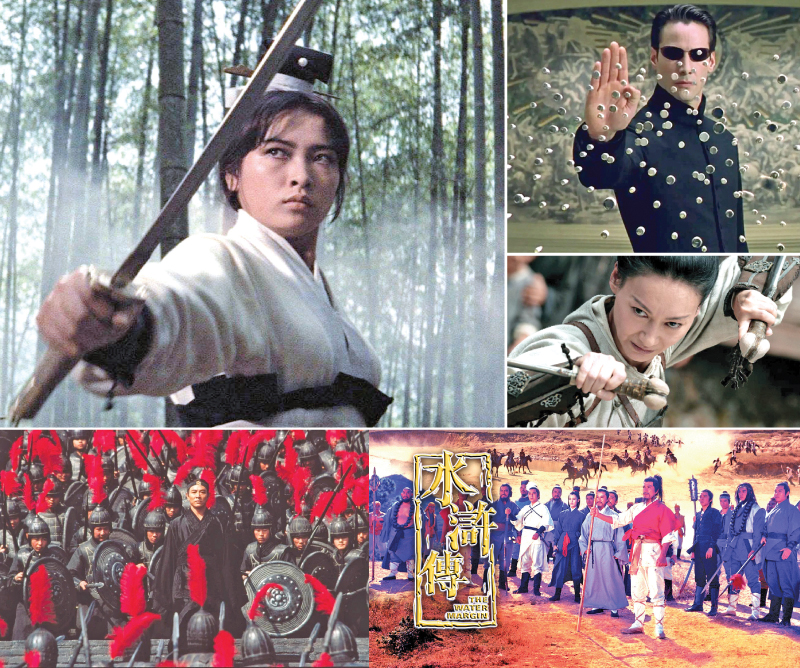 Wuxia, translating to ‘martial arts heroes/chivalry’, is a genre of Chinese fiction that revolves around martial artists (xia), chivalry and fighting against evil in the pursuit of justice. Wuxia media is often characterised by melodramatic plots and their signature high-flying combat scenes. Rooted in Chinese folklore, history and philosophy, wuxia stories depict wandering swordsmen and warriors who uphold honour and righteousness in a world filled with corruption and tyranny. Over centuries, wuxia has evolved from ancient oral traditions to a thriving literary and cinematic genre, influencing global pop culture.
Wuxia, translating to ‘martial arts heroes/chivalry’, is a genre of Chinese fiction that revolves around martial artists (xia), chivalry and fighting against evil in the pursuit of justice. Wuxia media is often characterised by melodramatic plots and their signature high-flying combat scenes. Rooted in Chinese folklore, history and philosophy, wuxia stories depict wandering swordsmen and warriors who uphold honour and righteousness in a world filled with corruption and tyranny. Over centuries, wuxia has evolved from ancient oral traditions to a thriving literary and cinematic genre, influencing global pop culture.
Though the term wuxia was coined relatively recently, the origins of the genre can be traced back to over 2000 years ago in ancient China, particularly in warring states legends and historical records. Wuxia has its roots in stories from around 300-200 BC of wandering warriors (youxia) and heroic assassins (cike) carrying out political assassinations, which used to be seen as noble. These stories were quite a popular phenomenon and appeared in historical texts such as Sima Qian’s ‘Records of the Grand Historian’, the ‘Book of Han’, and the ‘Book of the Later Han’. These stories chronicled youxia, or wandering knights, who lived outside government authority and adhered to a personal code of honor, quite similar to the Japanese stories of ronin.
Legendary tales
By the Tang Dynasty (618–907 CE), martial arts folklore became popular in the form of chuanqi or ‘legendary tales’ as poetry and short stories. The Tang poet Du Fu and storyteller Pei Xing introduced elements of chivalry and supernatural martial arts abilities into their works. However, wuxia as a distinct literary genre began taking shape during the Ming (1368–1644) and Qing (1644–1912) Dynasties, with novels such as ‘Water Margin’ (Shuihu Zhuan) and ‘Romance of the Three Kingdoms’ (Sanguo Yanyi) which are considered to be among the Great Classic Novels of China, featuring heroic warriors battling oppressive rulers and treacherous warlords. Water Margin is also credited as the first full-length wuxia novel, introducing some concepts that would go on to define the genre, such as the heroes having a strong code of honor, becoming outlaws against a corrupt government, as well as the Jianghu. The jianghu is a common setting in wuxia stories and is essentially a fictional version of ancient China that most wuxia authors use as a shared world.
The modern wuxia genre emerged in the early 20th century, particularly in Republican-era China (1912–1949). Xiang Kairan is considered to be the father of modern wuxia novels, and his published works would go on to inspire the first wuxia film, The Burning of the Red Lotus Temple (1923). Writers like Jin Yong (Louis Cha) and Gu Long revolutionized wuxia literature by blending traditional martial arts legends with deep character development, political intrigue, and philosophical themes.
Many of their works would be repeatedly adapted in Hong Kong, Taiwan, and mainland China, despite most wuxia stories being prohibited in those regions. Throughout China’s history, wuxia’s anti-authoritarian edge was considered a threat to the government, but later stories have leaned into more nationalistic and patriotic themes that have become popular in China.
Pop culture
In the 20th and 21st centuries, wuxia transitioned from literature to film and television, shaping Chinese and global pop culture. Hong Kong cinema in the 1960s–1980s produced iconic wuxia films, such as King Hu’s “A Touch of Zen” (1971) and Shaw Brothers’ martial arts epics. The 1990s–2000s saw international recognition of wuxia with films such as ‘Crouching Tiger, Hidden Dragon’ (2000) by Ang Lee, which won multiple Academy Awards. Wuxia themes also influenced Hollywood, inspiring films like “The Matrix” (1999) and Marvel’s ‘Shang-Chi’ (2021).










